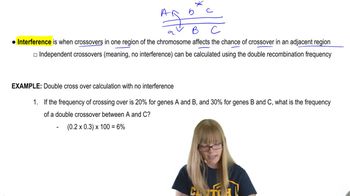The results shown are from a DNA test for four genes used in a paternity identification case. DNA for the mother (M) and her child (C) are shown along with DNA from two possible fathers, F1 and F2. In the 'C' column, label the DNA bands contributed by the mother with 'M' and the DNA bands contributed by the father with 'F.'
Table of contents
- 1. Introduction to Genetics51m
- 2. Mendel's Laws of Inheritance3h 37m
- 3. Extensions to Mendelian Inheritance2h 41m
- 4. Genetic Mapping and Linkage2h 28m
- 5. Genetics of Bacteria and Viruses1h 21m
- 6. Chromosomal Variation1h 48m
- 7. DNA and Chromosome Structure56m
- 8. DNA Replication1h 10m
- 9. Mitosis and Meiosis1h 34m
- 10. Transcription1h 0m
- 11. Translation58m
- 12. Gene Regulation in Prokaryotes1h 19m
- 13. Gene Regulation in Eukaryotes44m
- 14. Genetic Control of Development44m
- 15. Genomes and Genomics1h 50m
- 16. Transposable Elements47m
- 17. Mutation, Repair, and Recombination1h 6m
- 18. Molecular Genetic Tools19m
- 19. Cancer Genetics29m
- 20. Quantitative Genetics1h 26m
- 21. Population Genetics50m
- 22. Evolutionary Genetics29m
18. Molecular Genetic Tools
Methods for Analyzing DNA
Problem E.9
Textbook Question
Additional STR allele frequency information can be added to improve the analysis in Problem 8. The frequency of D8S1179₁₂ = 0.12. The frequency of D16S539₁₈ = 0.08 and of D16S539₂₀ = 0.21. Lastly, D18S51₁₉ = 0.13 and D18S51₂₀ = 0.10. Combine the allele frequency information for these three STR genes with the information used in Problem 8 to calculate the frequency of the genotype for six of the STR genes.
 Verified step by step guidance
Verified step by step guidance1
Identify the alleles for each of the three STR loci given: D8S1179 with allele 12 (frequency 0.12), D16S539 with alleles 18 (frequency 0.08) and 20 (frequency 0.21), and D18S51 with alleles 19 (frequency 0.13) and 20 (frequency 0.10).
Recall the allele frequencies from Problem 8 for the other three STR loci to have a total of six STR loci for the genotype frequency calculation.
Determine the genotype frequencies for each locus by applying the Hardy-Weinberg principle: for homozygous genotypes, use where is the allele frequency; for heterozygous genotypes, use where and are the frequencies of the two different alleles.
Calculate the genotype frequency for each of the six STR loci separately using the allele frequencies, including the new alleles provided for the three loci in this problem.
Multiply the genotype frequencies of all six STR loci together to obtain the combined genotype frequency for the six STR genes, assuming independence between loci.
 Verified video answer for a similar problem:
Verified video answer for a similar problem:This video solution was recommended by our tutors as helpful for the problem above
Video duration:
2mPlay a video:
Was this helpful?
Key Concepts
Here are the essential concepts you must grasp in order to answer the question correctly.
Short Tandem Repeats (STRs)
STRs are repeating sequences of 2-6 base pairs of DNA that vary in length among individuals. They are highly polymorphic markers used in genetic profiling and forensic analysis. Each STR locus can have multiple alleles, and their frequencies in a population help calculate genotype probabilities.
Recommended video:
Guided course

Duplications
Allele Frequency and Genotype Frequency
Allele frequency is the proportion of a specific allele among all alleles at a genetic locus in a population. Genotype frequency refers to the proportion of individuals with a particular combination of alleles. Calculating genotype frequency often involves combining allele frequencies, assuming Hardy-Weinberg equilibrium.
Recommended video:
Guided course

New Alleles and Migration
Multiplying Independent Loci Frequencies
When calculating the combined genotype frequency across multiple STR loci, the frequencies at each locus are multiplied together if loci are independent. This product gives the overall probability of observing a specific multi-locus genotype, which is essential in forensic and population genetics analyses.
Recommended video:
Guided course

Multiple Cross Overs and Interference

 7:40m
7:40mWatch next
Master Methods for Analyzing DNA and RNA with a bite sized video explanation from Kylia
Start learningRelated Videos
Related Practice
Textbook Question
520
views
